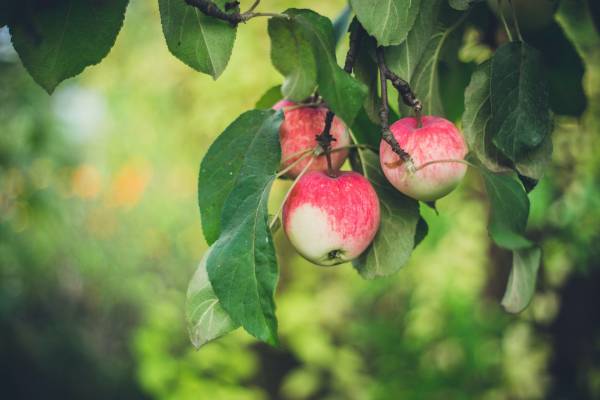You can cultivate apples in tropical settings where the minimum temperature does not fall below 12°C.
In that situation, you won’t need a cold climate—the once “deciduous” plant develops into an evergreen species and lives year-round.
Apples can grow cold climates, but have you ever wondered, “why do apples grow in cold climates?”.
It all began in Kazakhstan’s mountains in Central Asia. Apples originally started to grow in the northern regions of the planet.
Furthermore, they have persisted their winter hardiness for many years.
Keep reading to know more about why apples grow in cold climates.
Let’s dive in!

Origin of Apples
Himachal Pradesh was the place where apples were initially cultivated.
But owing to fruit specialists, apple farming is now feasible in many locations.
Apple trees can currently be planted in other climates as well, particularly in crowded places and arid regions. Near the equator in Indonesia, the Batu region effectively grows apples. African nations like Uganda, Zambia, Kenya, and Rwanda have started growing apples.
The producers may now easily harvest two crops annually from a single tree thanks to improved technology.
As a result, apple agriculture has evolved since 1980.
There have been initiatives to enhance apple production in regions with mild winters for the past 60 years. The best apple cultivars for low-altitude regions were the exclusive focus of research facilities.
Why Do Apples Grow in Cold Climates?
Apple trees and other trees that shed their leaves in the winter are examples of deciduous trees.
However, apples being cold hardy plants, can still grow in cold climates.
- Trees undergo intricate physiological changes that slow their growth and cause them to shed their leaves as winter approaches.
- This winter state is known as “dormancy.” The phenomenon is created by nature to protect these trees from the cold.
- The growth picks back again in the spring when the weather warms.
- For these trees to thrive again, the temperature must be below 45°F (7°C) for a predetermined period (in hours).
- Until then, they would not emerge from hibernation, and spring growth would not start again.
- The length of this exposure, or “cooling hours,” varies depending on the kind. From 150 to 1,500 cooling hours are needed for various apple varieties.
Apples may now be produced effectively in several locations. These apples sell for a fair price because they ripen earlier in June. Another benefit is that these trees begin producing fruit even when planted on seedling rootstock in the third year. The waiting period is thus extremely short.
Apple Varieties for Warmer Climates!
In warmer climates, you can plant the following apple varieties:
1. Anna
Abba Stein created it in the 1950s at the Israeli Kibbutz, Ein Shemer. It just requires 300 hours of chilling and is visually beautiful.
2. Dorsett Golden
Irene Dorsett discovered her Golden Delicious trees and Dorsett Golden apples in the Bahamas and gave them the name Dorsett Golden.
It can grow almost anywhere because it only requires 150 hours of chilling.
Related article: Can You Eat Crab Apples? Yes! Go Ahead and Take a Bite!
3. HRMN 99
This cultivar, HRMN 99, was first grown in India. As farmer Hariman Sharma from Bilaspur observed when he first encountered it almost ten years ago, it is a seedling that was haphazardly planted.
Sharma produced other plants from this seedling that he later planted on his land. They made excellent fruit not just on his land but also in other parts. Sharma then began growing and expanding this plant for financial gain.
Along with India, this apple has also been found to grow in South Africa, Germany, and Nepal.
The fruits from HRMN 99 are green or greenish-yellow in color.
No Winter Zones
Tropical areas with “no winter” and minimum temperatures of 12°C or above can also support the growth of apples.
Any kind will thrive here, even those that require a lot of freezing, like those from Canada or Russia.
The once “deciduous” apple plant now serves as an “evergreen” and lasts the entire year.
After undergoing all necessary freezes, plants are transferred from nurseries in the middle of February to achieve this. These are transported and planted in their new location within three to four days.
These plants can immediately begin to grow in any other location with a similar climate because their chilling requirements were already satisfied at the nursery.
Since there is no winter in these locations, there is no subsequent “dormancy” or leaf fall, which allows for unhindered growth. Like other tropical trees, these apple trees bear fruit and flourish all year.
Defoliation controls flowering, which allows one to produce fruits when it is most convenient for the grower.
One tree can produce two harvests.
This pattern has been successfully assessed in numerous locations for planting apples.
Here’s an interesting video regarding cold hardy apple trees:
With that said, that was all about why apples grow in cold climates.
Now, let’s head toward the conclusion.
Conclusion!
Simply put, the bulk of commercial apple tree cultivars prefer regions with chilly winters, copious amounts of precipitation, and cool springs and summers.
Exposure to sunlight is essential since it has a significant impact on the fruit’s color.
In general, apple trees require more cold than most other deciduous fruit plants. The most common apple tree species flourish in areas with temperatures that rarely rise over 90 degrees Fahrenheit (32°C). When the temperature rises too high, many apple producers also utilize big fans to cool the orchard.
Why do apples grow in cold climates, you asked? We hope this article answers your query.
I hope you liked today’s article. If yes, please consider sharing it with people. In case of any questions, please feel free to get in touch with us through the comments section!
Regards!
